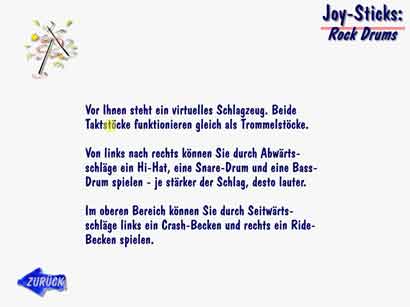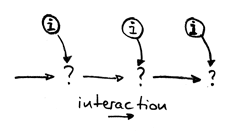| back to index | |||
H16 Information Just In Time ** |
|||
 WorldBeat screen for the Rock Drums feature. |
|||
|
....you are deciding when to explain features to the
user - Incremental Revealing, and when
to convey your messages so people remain in control of where they are
and what they have learned - Closed Loop}
|
|||
|
* * *
|
|||
| Occasionally, a system needs to explain how to continue, but
exhibit users do not read long instructions, let alone memorize them.
|
|||
| Spare short-term memory |
Not to strain short-term memory with complex instructions to be remembered is one of the most established user interface guidelines (see, e.g., [Shneiderman, 1998, p. 75]). Graphical user interfaces address this issue with the concept of "see and choose instead of remember and type in" [Shneiderman, 1998, p. 75]). However, with interactive exhibits, the situation is again more drastic. They often need to explain an unusual form of interaction, but at the same time there is a lack of long learning time or frequent use. Moreover, users may not even have seen instructions on a previous screen - Easy Handover. |
||
| WorldBeat: Condensed explanations |
WorldBeat only gives minimal information at the beginning, explaining very briefly what the system is about, and how to point the batons at the screen and select an on-screen start button. This is all users need to know to start using the system, and it is also all they wish to read at this moment. If someone takes over the system being used by a predecessor, they will have collected this information from watching the other user. Each instruction - for example how to play drums using the batons (see opening picture) - is only shown when the system is ready to let the user begin using the respective feature. We noticed users usually only stopping to read when they actually did not know how to continue, and were actively looking for help. We also frequently observed that WorldBeat users did not read longer texts explaining what to do, until those texts were redesigned to be even more succinct, clear, and constructive, as shown in the opening picture. |
||
|
Therefore: Delay usage instructions until users actually need to know about them to continue, and keep them as short as possible, usually no more than three sentences with twelve words each. |
|||
 |
|||
|
* * *
|
|||
|
If space is limited, you can make this information appear
dynamically only when needed - Dynamic Descriptor. |
|||
This pattern is taken from the book "A Pattern Approach to Interaction Design" (PAID) by Jan Borchers (John Wiley and Sons, Chichester, UK, 2001). Copyright 2001 John Wiley and Sons. Used by permission. See http://media.informatik.rwth-aachen.de/paid.html for more information. Online version by Susan Babutzka, ETH Zurich (subabutz_at_student.ethz.ch). |
|||